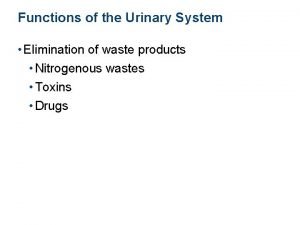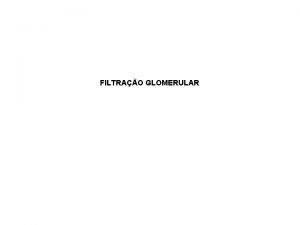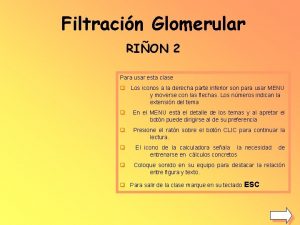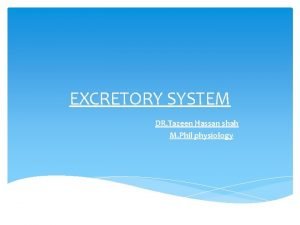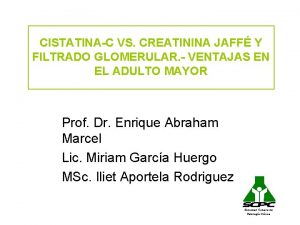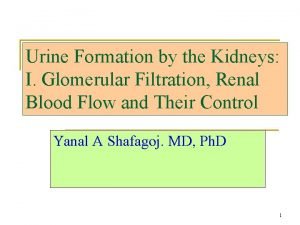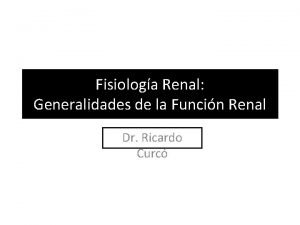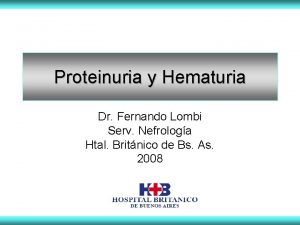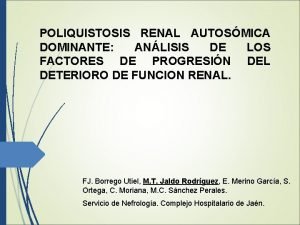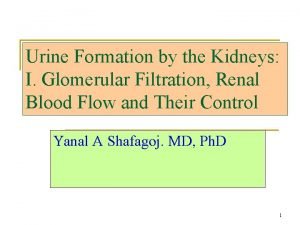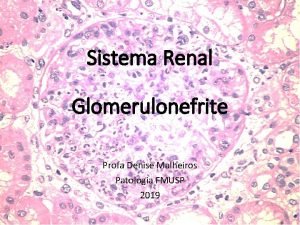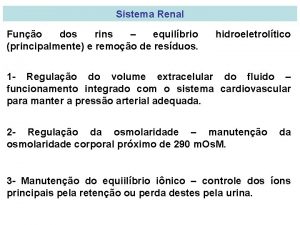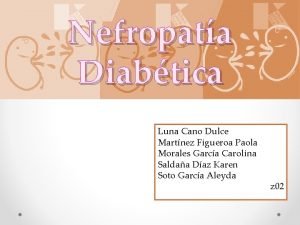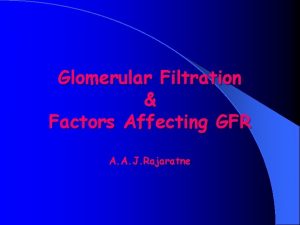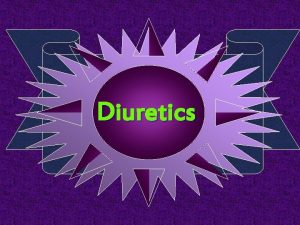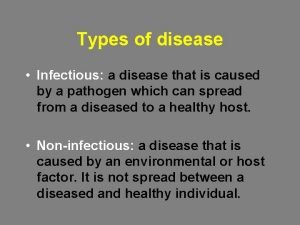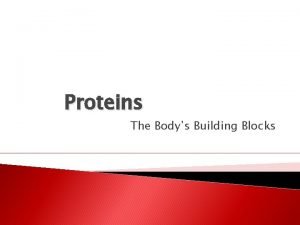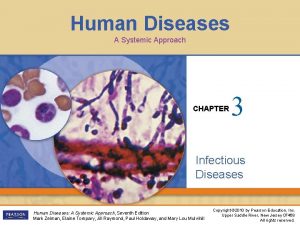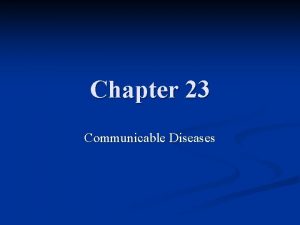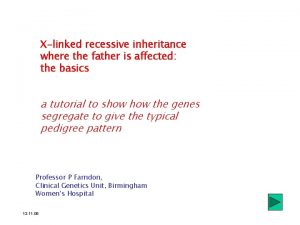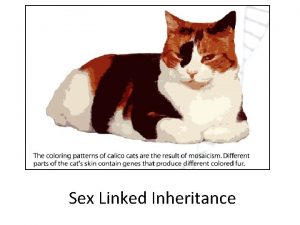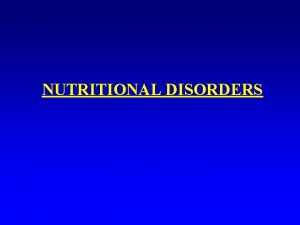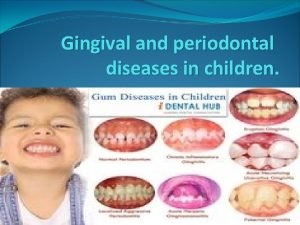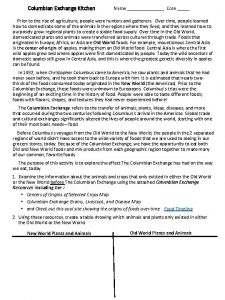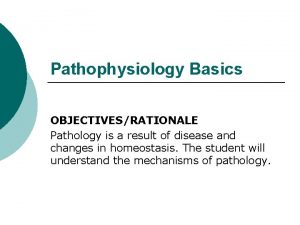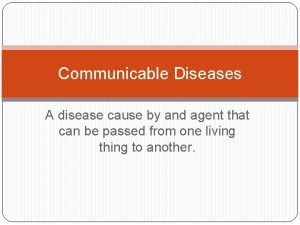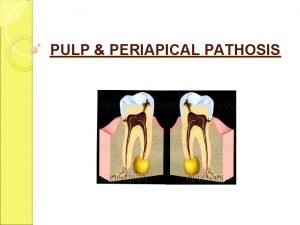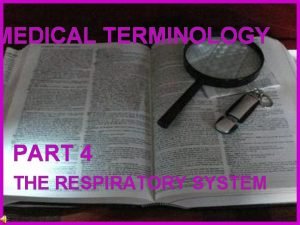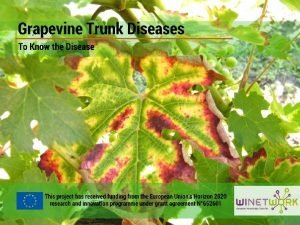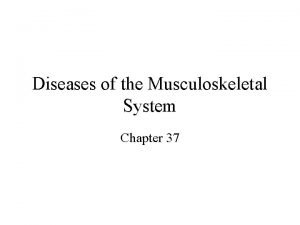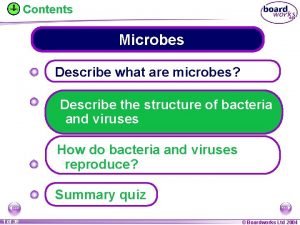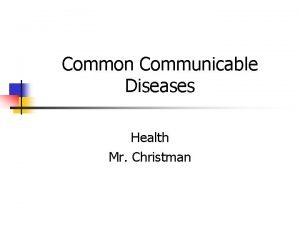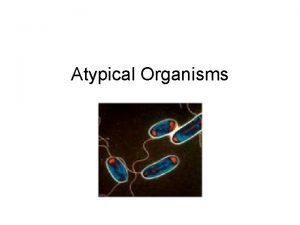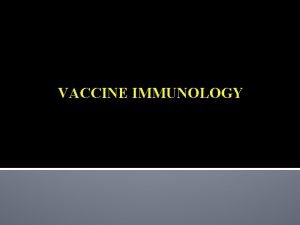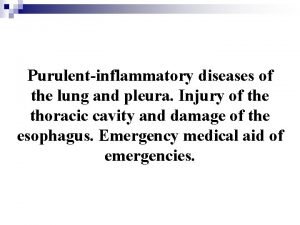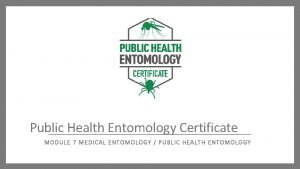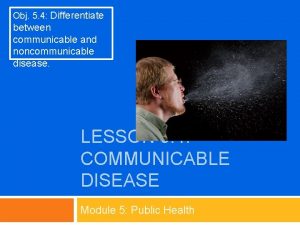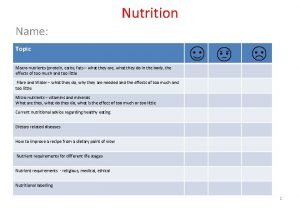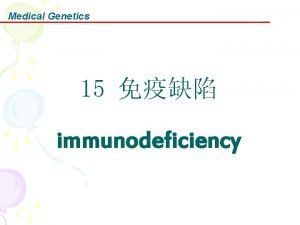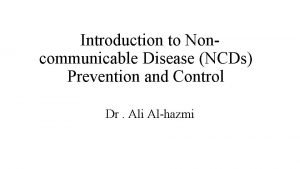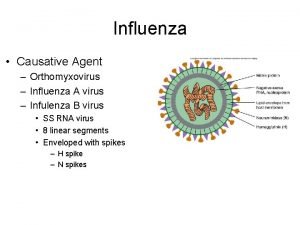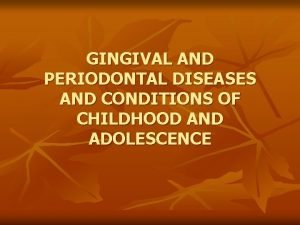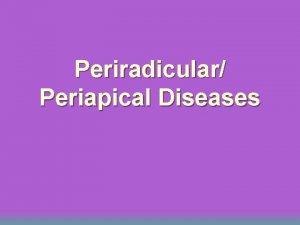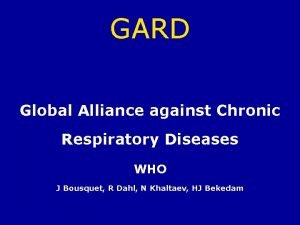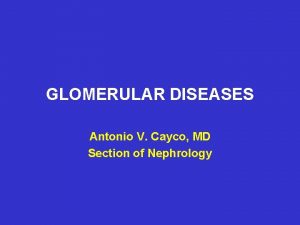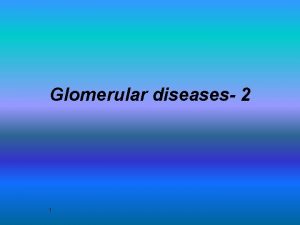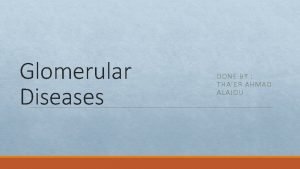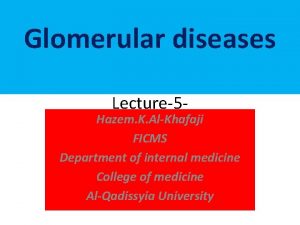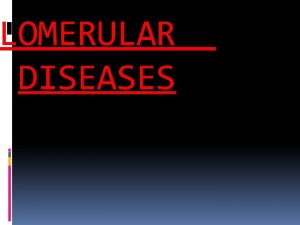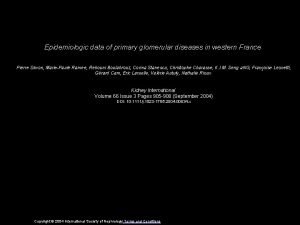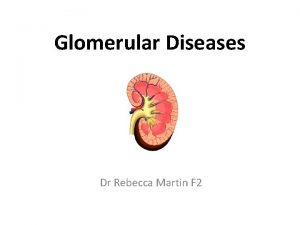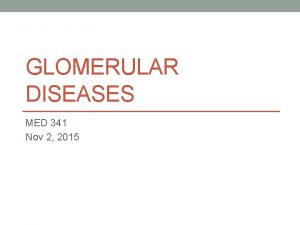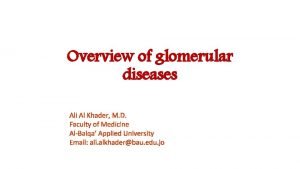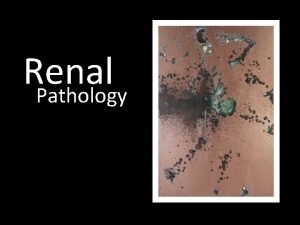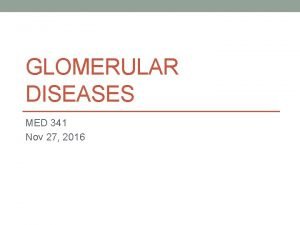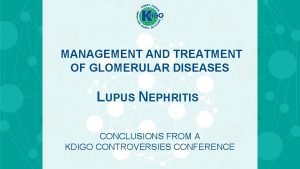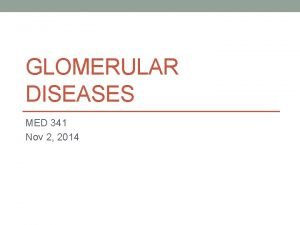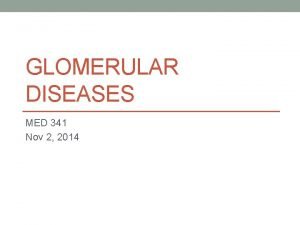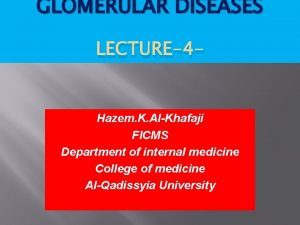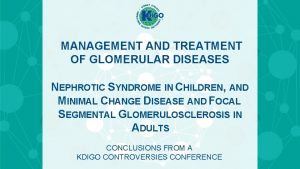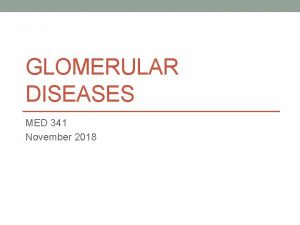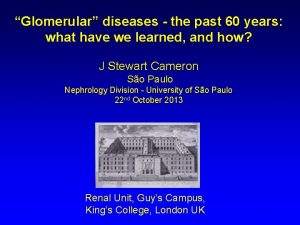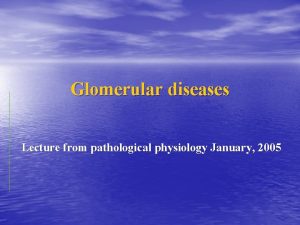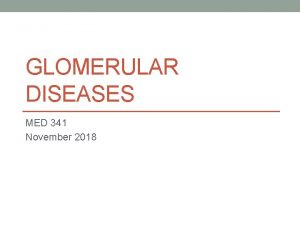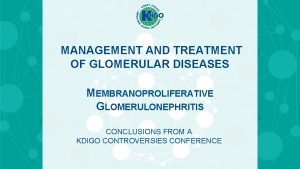GLOMERULAR DISEASES Antonio V Cayco MD Section of


































































































- Slides: 98

GLOMERULAR DISEASES Antonio V. Cayco, MD Section of Nephrology

OBJECTIVES Introduction Approach to Glomerular Diseases • Syndrome Diagnosis • Clinical Diagnosis • Histologic Diagnosis • Clinicopathologic Correlation General Principles of Management

CAUSES OF ESRD IN THE PHILIPPINES: Renal Registry Data, PSN, 2003 Cause/Etiology (%) ESRD Cases Diabetes mellitus 33 Glomerulonephritis 25 Hypertension 19

Afferent arteriole Parietal EC Capillary loop Endothelium Macula densa Mesangium JG cells Urinary space Efferent arteriole Visceral EC

Mesangium Normal Glomerulus

Normal glomerulus

PATHOLOGY Definition of Terms • Glomerulopathy vs. Glomerulonephritis • Primary vs. Secondary • Diffuse vs. Focal • Global vs. Segmental • Fibrosis vs. Sclerosis • Membranous vs. Proliferative • Endocapillary vs. Extracapillary

Fibrosis – increase in the deposition of collagen fibers Sclerosis – increase in the amount of homogenous nonfibrillar extracellular material Sclerosis

Segmental – lesion involves < 50% of the glomerulus Sclerosis Global – lesion involves > 50% of the glomerulus Sclerosis

Diffuse Global Glomerulosclerosis Focal – lesion seen in less than 50% of glomeruli Diffuse – lesion seen in more than 50% of glomeruli

Mesangial cells Normal glomerulus Proliferation – increase in the glomerular cell number Mesangial cells Mesangial proliferative. GN

Endocapillary proliferation Extracapillary proliferation

Normal glomerulus Membranous – expansion and thickening of the glomerular basement membrane (GBM) by immune deposits

Primary Mechanisms of Glomerular Injury Mechanism of Injury Renal Insults/ Defects Glomerular Disease Immunologic Immunoglobulin Immune-complex GN Cell-mediated injury Pauci-immune GN Cytokine Primary FSGS Complement activation MPGN Type II Hyperglycemia DM Nephropathy Fabry’s disease/ sialidosis FSGS Metabolic Hemodynamic Systemic hypertension Intraglomerular hypertension HTN Nephrosclerosis Secondary FSGS

Primary Mechanisms of Glomerular Injury Mechanism Renal Insults/ Defects of Injury Glomerular Disease Toxic E. coli-derived verotoxin Thrombotic microangiopathy Therapeutic drugs (NSAIDs) Minimal change disease Recreational Drugs (Heroin) FSGS Deposition Amyloid fibrils Amyloid nephropathy Infectious HIV Nephropathy Subacute Endocarditis Immune complex GN Inherited Genetic defect for 5 chain of Alport’s Syndrome type IV collagen Abnormally thin basement membrane Thin basement membrane disease

Immunologic Glomerular Injury Humoral Antibody-Mediated Injury • Autoantibodies against intrinsic antigens (example: Goodpasture’s syndrome) • Autoantibodies against extrinsic “trapped antigens (example: Postinfectious GN) • Trapping of circulating immune complexes (example: Cryoglobulinemic GN) Cellular Mediated Injury


GN Loss of nephrons Glomerular hyperfiltration Glomerular HTN Non-selective prtoteinuria Glomerular sclerosis Tubulointerstitial inflammation Ischemia Tubulointerstitial atrophy/fibrosis Two Final Common Pathways in Glomerular Injury

OBJECTIVES Introduction Approach to Glomerular Diseases • Syndrome Diagnosis • Clinical Diagnosis • Histologic Diagnosis • Clinicopathologic Correlation General Principles of Management

Approach to Glomerular Diseases • • Syndrome Diagnosis Clinical Diagnosis Histologic Diagnosis Clinicopathologic Correlation

Syndrome Diagnosis History Physical Examination Ancillary Laboratory Tests • Chemistry • Serology • Urinalysis

Syndromes in Glomerular Diseases Syndrome Clues to Diagnosis Common Findings Rapidly Progressive Renal Failure (RPRF) Anuria Oliguria Decline in GFR over weeks HTN, Hematuria, Proteinuria, Pyuria Nephritic Syndrome Hematuria, RBC casts, Azotemia, Oliguria, Edema, HTN Proteinuria,

Syndromes in Glomerular Diseases Syndrome Clues to Diagnosis Common Findings Nephrotic Syndrome Proteinuria > 3. 5 gms Hypoalbuminemia Hyperlipidemia Lipiduria Casts Edema Asymptomatic Isolated hematuria urinary Isolated proteinuria abnormality (AUA)





Approach to Glomerular Diseases • • Syndrome Diagnosis Clinical Diagnosis Histologic Diagnosis Clinicopathologic Correlation


C-ANCA: Cytoplasmic Antineutrophil Cytoplasmic Antibodies C-ANCA • Antibodies against Proteinase 3 • Associated with Wegener’s ggranulomatosis

P-ANCA: Perinuclear Antineutrophil Cytoplasmic Antibody P-ANCA • Antibodies against myeloperoxidase • Associated with a variety of vasculitides • Non-specific for Wegener’s granulomatosis

Clinical Diagnosis Disease Renal Syndrome Clinical Features Diabetic nephropathy Nephrotic CRF Chronic course, (+) DM retinopathy, nl-sized kidneys, bland urine sediment Goodpasture’s syndrome Nephritic RPRF anti. GBM-aby (+), c. ANCA (-), nl C 3 Wegener’s Nephritic granulomatosis RPRF anti. GBM-aby (-), c. ANCA (+), nl C 3

Clinical Diagnosis Disease Renal Clinical Features Syndrome Lupus nephritis Nephritis RPRF anti. GBM-aby (-), c. ANCA (-), low C 3, ANA (+), (+) ACR criteria for the diagnosis of SLE Poststreptococcal Nephritis GN anti. GBM-aby (-), c. ANCA (-), low C 3, ASO (+), prior Streptococcal infection

Approach to Glomerular Diseases • • Syndrome Diagnosis Clinical Diagnosis Histologic Diagnosis Clinicopathologic Correlation

Indications for a Kidney Biopsy • • Unexplained ARF Unexplained RPRF Adult nephrotic syndrome w/out systemic disease Proteinuria < 2 g/d w/ deterioration of renal function Proteinuria > 2 g/d DM w/ acute onset of proteinuria and renal failure DM with proteinuria but w/out retinopathy Selected cases of Lupus nephritis

Crescent

Membrane thickening Mesangial expansion Cellular proliferation MPGN

Deposits Splitting MPGN


Normal glomerulus

Fusion of foot processes Minimal Change Disease

Sclerosis FSGS

Foot process fusion FSGS

Membranous Nephropathy

Deposits Membranous GN

Mesangial proliferation

Mesangial Ig. A Deposits

Ig. A Nephritis

Approach to Glomerular Diseases • • Syndrome Diagnosis Clinical Diagnosis Histologic Diagnosis Clinicopathologic Correlation

Clinicopathologic Correlation Syndrome Diagnosis Histologic Diagnosis Etiologic Diagnosis Nephritic Diffuse Immune complex GN (>70%)* Proliferative GN Pauci-immune GN (<30%)** Nephritic Nephrotic Membrano. Immune complex GN* Proliferative GN Thrombotic microangiopathy RPRF Crescentic GN Isolated hematuria Mesangial Ig. A nephropathy Proliferative GN HSP Immune complex GN ( 45%)* Pauci-immune GN ( 45%)** Anti-GBM disease ( 10%) * SLE, Postinfectious GN, IE, Cryoglobulinemia ** Wegener’s granulomatosis, Microscopic PAN

Clinicopathologic Correlation Syndrome Histologic Diagnosis Etiologic Diagnosis Nephrotic Minimal Change Disease (MCD) Idiopathic, drugs, heroin, HIV, lymphoma Nephrotic Focal Segmental Glomerulosclerosis (FSGS) Idiopathic, HIV, heroin, secondary forms from reduced nephron number Nephrotic Membranous Glomerulopathy Idiopathic, infections, drugs, autoimmune diseases, paraneoplastic syndrome Nephrotic CRF Nodular sclerosis DM nephropathy Chronic GN

Wire Loop Cellular proliferation Lupus nephritis

TRI Lupus Nephritis

Postinfectious GN

Postinfectious GN

DM Nephropathy

Collapsing FSGS Sclerosis

Tubuloreticular Inclusion bodies

Amyloid


SAMPLE CASE • 28 year old female referred for acute onset of pedal edema X 1 week • No other associated signs and symptoms • Single; sexually active; silent past medical history; not on any medications; no history of IVDA • ROS: denies other symptoms • Well-nourished, not obese • BP = 120/80, clear BS • Grade III pedal edema

SAMPLE CASE • Serum creatinine = 0. 7 mg/dl (nl) • Albumin = 2 g/L (low); Cholesterol = 300 mg/dl (high); FBS = 100 mg/dl (nl) • CXR: normal; UTS of kidneys: normal • Urinalysis: +4 protein, 0 -1 RBC/hpf, 0 -1 WBC/hpf, no casts • 24 -hour urine study: creatinine clearance of 98 cc/min and proteinuria of 4. 5 g/day

Approach to Glomerular Diseases • • Syndrome Diagnosis Clinical Diagnosis Histologic Diagnosis Clinicopathologic Correlation

SAMPLE CASE What is the renal syndrome present? • Nephritic syndrome • Nephrotic Syndrome • Rapidly progressive renal failure • Asymptomaric urinary abnormality

SAMPLE CASE Answer: Nephrotic syndrome • Edema • Hypoalbuminemia • Hyperlipidemia • Proteinuria > 3. 5 g/day

Approach to Glomerular Diseases • • Syndrome Diagnosis Clinical Diagnosis Histologic Diagnosis Clinicopathologic Correlation

SAMPLE CASE Is it possible to make a clinical diagnosis? • Yes or No ? • If yes, what is your clinical diagnosis? • If no, is a kidney biopsy indicated?

SAMPLE CASE Answer: No • No signs of systemic disease, ROS negative for other symptoms • PE normal except for edema • Normal FBS • Adult nephrotic syndrome – unlike children, no room for empiric steroid therapy • Kidney biopsy indicated

Approach to Glomerular Diseases • • Syndrome Diagnosis Clinical Diagnosis Histologic Diagnosis Clinicopathologic Correlation

Sclerosis

Foot process fusion

SAMPLE CASE Histologic Diagnosis: • Focal segmental glomerulosclerosis

Approach to Glomerular Diseases • • Syndrome Diagnosis Clinical Diagnosis Histologic Diagnosis Clinicopathologic Correlation

SAMPLE CASE • What are the possible causes of FSGS? • What additional test/s is/are needed? • Is this primary vs. secondary FSGS?

Etiology of FSGS Idiopathic (Majority) Systemic Diseases or Drugs • HIV • Diabetes mellitus • Fabry’s disease • Sialidosis • Charcot Marie-Tooth Disease • Heroin

Etiology of FSGS Congenital Oligonephropathies Acquired nephron loss • Surgical resection • Reflux nephropathy • Chronic GN/ renal disease Other adaptive responses • Sickle-cell nephropathy • Obesity with sleep apnea • Familial dysautonomia

SAMPLE CASE • No signs of systemic diseases • No history or sign (normal kidneys on UTS) of nephron loss • Not obese • No history of IVDA/ heroin use • Sexually active – need to rule out HIV • HIV ELISA test ordered – negative • Final diagnosis: Idiopathic Primary FSGS

OBJECTIVES Introduction Approach to Glomerular Diseases • Syndrome Diagnosis • Clinical Diagnosis • Histologic Diagnosis • Clinicopathologic Correlation General Principles of Management

General Principles of Management • Disease-specific therapy for primary and secondary GN • Therapy to retard the progression of disease • Therapy to address complications

Disease-specific therapy GN Loss of nephrons Glomerular hyperfiltration Glomerular HTN Non-selective prtoteinuria Glomerular sclerosis Tubulointerstitial inflammation Ischemia Tubulointerstitial atrophy/fibrosis Two Final Common Pathways in Glomerular Injury

Disease-Specific Therapy for Primary (Idiopathic) GN Syndrome Disease Therapy Nephritic MPGN Aspirin plus dipyridamole Nephrotic MCD Steroids Nephrotic FSGS Steroids Nephrotic Membranous Steroids plus chlorambucil (Ponticelli protocol)

Disease-Specific Therapy for Secondary GN Syndrome Disease Therapy Nephritic Poststreptococcal GN Penicillin; supportive RPRF Wegener’s granulomatosis Steroids plus PO cyclophosphamide RPRF Goodpasture’s syndrome Plasmapharesis Nephritic Lupus nephritis IV Steroids, IV cyclophosphamide Nephrotic Hep B membranous GN Interferon Nephrotic MCD due to NSAIDs Discontinue offending drug

GN Loss of nephrons Glomerular hyperfiltration Measures to delay progression Glomerular HTN Non-selective prtoteinuria Glomerular sclerosis Tubulointerstitial inflammation Ischemia Tubulointerstitial atrophy/fibrosis Two Final Common Pathways in Glomerular Injury

Renoprotective Strategies (Hebert, 2000) • • • Control blood pressure (< 127/75). (1) Use of ACE-I for BP. (1) Control of blood glucose for diabetics. (1) Limit protein intake to 0. 8 g/kg IBW/day. (1) Limit Na. Cl intake (2 -3 g/day). (3) Control lipids using statins (HMG-Co. A reductase inhibitor therapy). (2) • Avoid cigarette smoking. (2) • Avoid regular intake of NSAIDs. (3) ( ) Level of Recommendation

Renoprotective Strategies (Hebert, 2000) • Control plasma homocysteine level using folic acid (2 -15 mg/d). (3) • Control hyperinsulinemia (exercise and weight reduction). (3) • Use of antioxidants (Vit C and Vit E). (3) • Correct anemia (Hg. B 11 -12). (2) • Avoid hypokalemia. (3) • Control hyperphosphatemia. (3) • Low dose ASA. (3) • Estrogen replacement for women. (3) ( ) Level of Recommendation

Treatment of Complications • Diuretics to control edema. • ACE-I/AII-RBs to control BP. • Anticoagulants (warfarin) for hypercoagulable states. • Statins for hyperlipidemia • Measures to prevent osteoporosis for patients on steroids (Calcium, Vit D, biphosphonates). • Co-trimoxazole to prevent Pneumocystic pneumonia for patients on steroids

SUMMARY Introduction Approach to Glomerular Diseases • Syndrome Diagnosis • Clinical Diagnosis • Histologic Diagnosis • Clinicopathologic Correlation General Principles of Management

HUS Thrombi

DM Nephropathy

DM Nephropathy

Membranous GN (Silver stain) Spikes

Immunofluoresence- Membranous GN

Mesangial proliferation Lupus Nephritis

Lupus Nephritis Membrane thickening

TRI Membranous Lupus GN

Immunofluorescence- Postinfectious GN

RPGN

Immunofluoresence: Anti-GBM Disease
 Section 19-3 diseases caused by bacteria and viruses
Section 19-3 diseases caused by bacteria and viruses Nephron def
Nephron def Slender tubes attaching the kidney to the bladder
Slender tubes attaching the kidney to the bladder Arteriola aferente
Arteriola aferente Filtracin
Filtracin Dr hassan shah
Dr hassan shah Filtrado glomerular formula korotkoff
Filtrado glomerular formula korotkoff Peritubular capillaries
Peritubular capillaries Filtracion renal
Filtracion renal Kidneys location and structure figure 15-1
Kidneys location and structure figure 15-1 Ion trapping definition
Ion trapping definition Hematuria glomerular y extraglomerular
Hematuria glomerular y extraglomerular Filtrado glomerular
Filtrado glomerular Glomerular filtration
Glomerular filtration Capillary filtration coefficient
Capillary filtration coefficient Barreira de filtração glomerular
Barreira de filtração glomerular Pressão hidrostática capilar
Pressão hidrostática capilar Hiperfiltracion glomerular
Hiperfiltracion glomerular Filtração glomerular fisiologia
Filtração glomerular fisiologia Explain the factors affecting gfr
Explain the factors affecting gfr Glomerular filtration
Glomerular filtration Type of disease
Type of disease Management gurus and their contributions
Management gurus and their contributions Protein deficiency diseases
Protein deficiency diseases Natural history of disease ppt
Natural history of disease ppt Modern lifestyle and hypokinetic diseases
Modern lifestyle and hypokinetic diseases Major nutritional deficiency diseases in emergencies
Major nutritional deficiency diseases in emergencies Abcsses
Abcsses Iceberg phenomenon of disease
Iceberg phenomenon of disease Human diseases a systemic approach
Human diseases a systemic approach Communicable and noncommunicable diseases venn diagram
Communicable and noncommunicable diseases venn diagram Chapter 24 lesson 1 sexually transmitted diseases
Chapter 24 lesson 1 sexually transmitted diseases Periradicular disease classification
Periradicular disease classification Define a primary skin lesion and list three types
Define a primary skin lesion and list three types Chapter 6 musculoskeletal system diseases and disorders
Chapter 6 musculoskeletal system diseases and disorders Chapter 32 childhood communicable diseases bioterrorism
Chapter 32 childhood communicable diseases bioterrorism Chapter 24 sexually transmitted diseases and hiv/aids
Chapter 24 sexually transmitted diseases and hiv/aids Chapter 23 communicable diseases
Chapter 23 communicable diseases Chapter 22 genetics and genetically linked diseases
Chapter 22 genetics and genetically linked diseases Chapter 21 mental health diseases and disorders
Chapter 21 mental health diseases and disorders Chapter 17 reproductive system diseases and disorders
Chapter 17 reproductive system diseases and disorders Chapter 15 nervous system diseases and disorders
Chapter 15 nervous system diseases and disorders Milady chapter 10 nail disorders and diseases
Milady chapter 10 nail disorders and diseases Chapter 10 lymphatic system diseases and disorders
Chapter 10 lymphatic system diseases and disorders X linked diseases
X linked diseases Whats a sex linked trait
Whats a sex linked trait Helminthic diseases
Helminthic diseases Nutritional diseases
Nutritional diseases Nutritional diseases
Nutritional diseases Nutritional diseases
Nutritional diseases King of diseases
King of diseases Lamina dura radiografi
Lamina dura radiografi Non communicable diseases
Non communicable diseases Diseases spread by columbian exchange
Diseases spread by columbian exchange Elsevier
Elsevier In what situation should a nail service be performed
In what situation should a nail service be performed Diseases spread by columbian exchange
Diseases spread by columbian exchange Std
Std What causes genetic diseases
What causes genetic diseases Certain infectious and parasitic diseases
Certain infectious and parasitic diseases Nursing management of reproductive tract infection
Nursing management of reproductive tract infection Examples of communicable diseases
Examples of communicable diseases Chapter 8 cardiovascular system
Chapter 8 cardiovascular system Pulpitis classification
Pulpitis classification Capnia suffix
Capnia suffix Grapevine trunk diseases
Grapevine trunk diseases Diseases of the musculoskeletal system
Diseases of the musculoskeletal system Diseases caused by bacteria
Diseases caused by bacteria Non common communicable diseases
Non common communicable diseases Milady chapter 8 skin disorders and diseases
Milady chapter 8 skin disorders and diseases Diseases caused by dust
Diseases caused by dust Diseases
Diseases Diseases with vaccines
Diseases with vaccines Diseases in civil war
Diseases in civil war Non communicable diseases infographic
Non communicable diseases infographic Female reproductive system diseases
Female reproductive system diseases Venn diagram of communicable and non-communicable diseases
Venn diagram of communicable and non-communicable diseases Purulent diseases of lungs and pleura
Purulent diseases of lungs and pleura Zoonotic diseases
Zoonotic diseases Tronsmo plant pathology and plant diseases download
Tronsmo plant pathology and plant diseases download Tronsmo plant pathology and plant diseases download
Tronsmo plant pathology and plant diseases download Tronsmo plant pathology and plant diseases download
Tronsmo plant pathology and plant diseases download Conclusion of plant diseases
Conclusion of plant diseases Difference between communicable and noncommunicable
Difference between communicable and noncommunicable Vitamin deficiency diseases chart
Vitamin deficiency diseases chart Where is kidney pain felt diagram
Where is kidney pain felt diagram Immunocompromised diseases list
Immunocompromised diseases list Vitamins functions
Vitamins functions Myth and fallacies about non-communicable diseases
Myth and fallacies about non-communicable diseases Causative agent of influenza is
Causative agent of influenza is Monocyte derived dendritic cells
Monocyte derived dendritic cells Diseases spread by pathogens
Diseases spread by pathogens Normal gingiva in child
Normal gingiva in child Epidemiological triad
Epidemiological triad Polysaprobic
Polysaprobic Periradicular tissues are
Periradicular tissues are Global alliance against chronic respiratory diseases
Global alliance against chronic respiratory diseases Waterwashed diseases
Waterwashed diseases Chapter 23 lesson 1 understanding communicable diseases
Chapter 23 lesson 1 understanding communicable diseases


